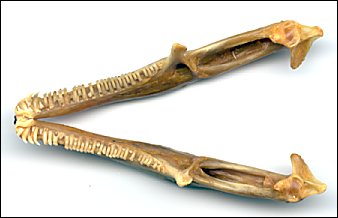

You aren't likely to hear a lizard tell its offspring to chew their food carefully. Yes, I know, lizards can't really talk. But the principle's there—few living land-dwelling animals aside from us mammals really chew their food. In fact, one of the great evolutionary advances of our distant ancestors was the stabilization of the number and placement of teeth. To be efficient chewers, upper teeth have to meet lower teeth rather exactly.
But peer into the mouth of any of our desert reptiles, and you'll see that not only do teeth not meet exactly, but there often are gaps without mature teeth. Indeed, most reptiles lose and regrow teeth many times during a lifetime, while we're stuck with only two generations of them.
So what's the advantage? Our high temperature and fast way of life
requires rapid processing of large amounts of food, and digestive juices work much
faster on small particles than large chunks. A snake can afford to take days to digest
a whole mouse—we can't and still keep up the pace our lives demand.

Contributor: Arthur H. Harris, Laboratory for Environmental Biology, Centennial Museum, University of Texas at El Paso.
Desert Diary is a joint production of the Centennial Museum and KTEP National Public Radio at the University of Texas at El Paso.

This view of the lower jaws of a lizard reveals the simple nature of the teeth and various teeth in the process of being replaced. Scanned image by A.H. Harris.
Vaughn, T. A. 1986. Mammalogy. 3rd ed., CBS College Publishing, New York. 576 pp.